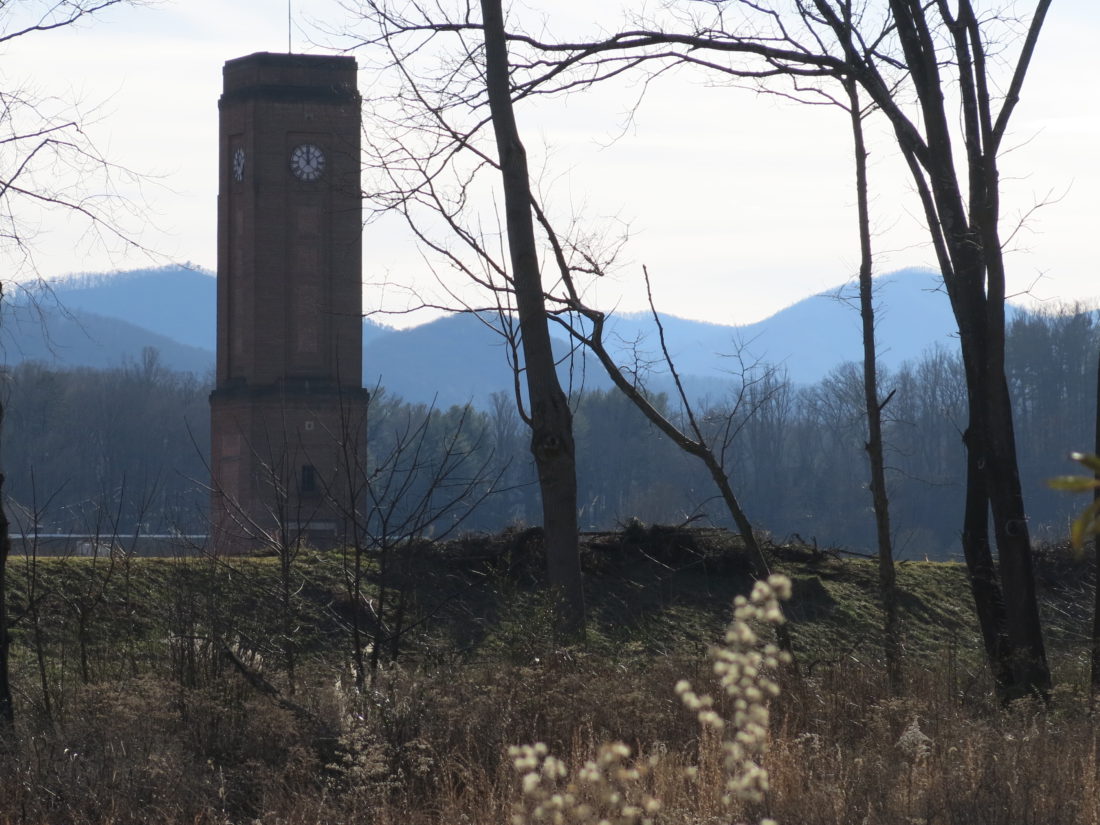For decades, workers set their watches by the clock tower that now looms over a vacant lot in Enka. As the last remaining building of the former American Enka Co., a rayon fiber manufacturer that opened in Asheville in the late 1920s and kept thousands employed through the Great Depression, the 139-foot structure now symbolizes the community’s industrial history.
But in recent weeks — after an ad hoc group of concerned citizens petitioned against plans to raze the clock tower as part of a construction project by Greensboro-based Samet Co. — the edifice has taken on even greater meaning to many local historians, preservationists and community members: a win for recognition of the past in the face of present development.
In a Nov. 25 press release, Brian Hall, director of development for Samet Co., stated that the clock tower would be incorporated into revised plans for the project. “All parties involved in the development of this area recognize the historic role the monument plays in Asheville’s history, and we would like the tower to stand for generations to come,” Hall declared.
Amid the region’s booming real estate market, says Anne Chesky Smith, executive director of the Western North Carolina Historical Association, the effort to preserve the tower exemplifies how other local groups might organize when similar iconic structures or neighborhoods come under threat.
Those leading the Enka charge solicited support not only from historical organizations, she points out, but also community members with deep connections to the former plant –– a strategy that ultimately paid off. “There is certainly strength in numbers,” Chesky Smith says of the nearly 4,000 signatures gathered in two weeks to protest the tower’s demolition.
Forgotten treasures
Katherine Cutshall, collections manager for the North Carolina Room at Pack Memorial Library, notes that preservation is part of the way area residents define themselves.

“The most important thing for developers to hear is what the community thinks about a given historical property,” she says. “Preservation and interpretation of historic properties and landmarks are ways that we as a culture reveal to outsiders what is most important to us.”
The process for determining significant structures, continues Cutshall, needs to be ongoing. She suggests a regular survey of the community to identify unregistered historical properties and understand why those structures are viewed as important.
That outreach is particularly crucial in the county’s rural areas, which Cutshall says often get overlooked for preservation efforts. Significant barns, springhouses and other community structures become vulnerable to demolition as developers spread beyond Asheville’s urban core.
Cutshall references the Sandy Mush High School building, which operates today as the Sandy Mush Community Center, as one such example. Though it lacks the prestige of a Richard Sharp Smith-designed mansion, the building still warrants preservation, she opines, because “it serves as an important community gathering place … for Sandy Mush and Leicester residents.”
A similar dynamic is true for many less affluent neighborhoods within city limits, says Jessie Landl, executive director of the Preservation Society of Asheville and Buncombe County. Looking ahead, she’s especially concerned about the future of the Shiloh community, a historically Black neighborhood in South Asheville established in the 1880s.
“There is some really special architecture in that neighborhood,” she says. “But I think we’re going to start seeing some serious development pressure there as well.”
Effective change
Beyond the Preservation Society, Landl and other public historians are quick to note the Western Office of the N.C. Department of Cultural Resources and the joint city-county Historic Resources Commission as major assets to the area’s local preservation efforts.
But what’s missing, says Cutshall, are opportunities for greater collaboration within the field. “Right now, there is no group of local historians and preservationists that meets regularly to discuss what projects we’re all working on,” she says. A monthly exchange among organizations, she believes, could help anticipate — or de-escalate — potential threats to historic structures.
Both Cutshall and Chesky Smith agree historians should do more than document the past: Public engagement and community service are essential. “It is important for historians to be present on city and county boards that make the decisions about how development occurs,” Chesky Smith says.
That doesn’t always mean advocating for a historic structure to stay. Cutshall, along with archivist Elizabeth Harper, were among the 12 individuals selected to the Vance Monument Task Force. Both voted in the majority in the 11-1 decision to remove the monument after 12 weeks of reviewing written public comments and participating in two virtual town hall sessions.
“I voted on behalf of an overwhelming majority of commenters as well as my own personal convictions,” Cutshall explains. The monument’s construction, she explains, was the unilateral decision of George Pack, a lumber tycoon who arrived in Asheville in 1884, who donated the land that now makes up Pack Square to the city of Asheville near the turn of the 20th century. “Now we, as a community, have had this opportunity to reach a conclusion together, and I think that’s really the most important and impactful part of this decision,” Cutshall notes.
Lessons in history
Within the private sector, however, historians are not often consulted, opening the door for ill-informed and controversial decisions. “My guess is that the developers who planned to raze the clock tower had no idea that it was of historical significance to residents,” says Cutshall. (Samet Co. representatives did not respond to a request for comment beyond their Nov. 25 press release.)

At the Preservation Society, Landl regularly works to foster partnerships between her organization and developers. Unfortunately, she notes, it’s not always easy to get someone to return her phone calls.
“It can be really challenging because they’re not invested in the community the way we are,” she explains of developers from beyond WNC. “But I think that there are opportunities to educate developers coming in from out of town.”
That education itself, emphasizes author David Whisnant, needs to be specific.
“It seems to me there are aspects of Asheville’s history that have not been adequately dealt with,” he says. Working-class, industrial and Black history are among the major topics that demand further research, he believes.
“If those sectors of history can be foregrounded more often and be factored in as standard features of the larger history, then I think people will be alert to the needs for more grounded and more particularized discussions,” Whisnant continues, which in turn might lead developers to design more sophisticated and culturally attuned plans.
Taking matters into his own hands, Whisnant is currently working on a written history of the Enka plant — highlighting both the company’s achievements and its shortcomings in the areas of race relations, gender equality and the environment. Whisnant, who grew up in the American Enka mill village in the 1940s, plans to publish his research on his blog, Asheville Junction, in the coming weeks.
Shaping memories
Local experts acknowledge that a complex balance exists between preservation and progress. “We should know that it is impossible to save every historic structure in Buncombe County and Western North Carolina,” notes Cutshall.
But there are benefits to saving what can be saved –– whether it’s a clock tower, a row of historic homes or a farmhouse.
“While there will always be a need to build new structures, adaptively reusing existing structures — especially historic structures — creates, maintains and builds a sense of community,” explains Chesky Smith. “Not only does reuse … reduce our environmental impact, but these historic structures often feature elements that we can’t replicate anymore for a variety of reasons. In some cases, like homes that were built with American chestnut, the materials simply don’t exist anymore.”
But ultimately, argues Cutshall, preservation decisions must come from the community itself, as happened with the Enka tower. “Together, ‘the public’ is a multitude of voices that will shape our historical memory,” she says. “So they should always have a say in the physical representations of that memory.”




This is timely, considering the debate over preservation or destruction of a Richard Sharpe Smith piece of architecture, namely the Vance Monument. The Society apparently urged that the monument be repurposed and/or contextualized. The current recommendation, however, seems to be “removal,” which may mean dismantling/destroying. What is the Society’s position on that?
Of course the first comment is the monument – the
“Richard Sharpe Smith piece of architecture”. As I’ve said before, even an esteemed architect can put out a bad one, and that giant phallus is a perfect example. Some things are not worth keeping.
I don’t know. Rig up a giant belt sander and give it a smooth finish, you’ve got a dandy new obelisk. Maybe dedicate to the Egyptian goddess Bast, of protection and cats. That sounds like Asheville.
https://simple.wikipedia.org/wiki/Bast